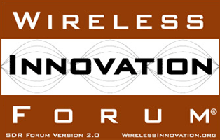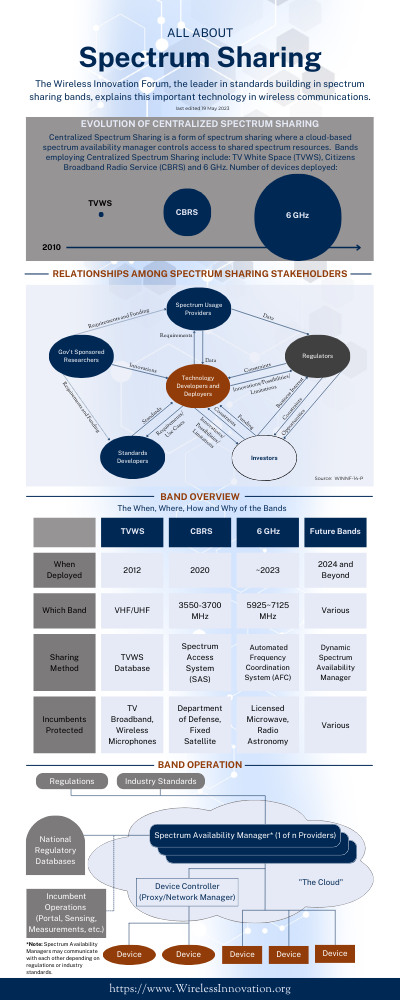- Home
- Knowledge Center
- Reports, Recommendations and Specifications
- Information Documents
- All About Spectrum Sharing Infographic
- Free Webinars
- Tech Talks
- Setting the Standard Video Blog
- Beyond the Radio Dial Video Blog
- Conference Proceedings
- Workshop Proceedings
- Springer Journals
- Market Studies
- What is the SCA?
- Issue Submissions
- Reference Implementations
- What is SDR?
- What are CR and DSA?
- About Us
- Events
- News
- Projects & Committees
- Members
- Join the Forum
Wireless Innovation Forum Top Ten Most Wanted InnovationsInnovation #6: Receiver Performance Interference Thresholds6.1 Executive SummaryThe growing movement to encourage spectrum sharing will be a significant enabler for novel radio communication solutions. However, existing spectrum users have a reasonable expectation that their systems operation will not be impaired by new in-band and adjacent band users. Historically, this has been managed through a variety of standards and regulations primarily focused on transmitter parameters, sometimes with unexpected consequences. The Forum believes that the entire range of both transmitter and receiver characteristics must become an integral part of spectrum regulation and management. Specifically, focus should be added to both defining the expectation of interference based on receiver performance in each band and informing regulatory decisions based on that expectation. This latter includes understanding the current and expected roadmap for receiver technology advances. Focusing on receiver performance and associated interference thresholds, can bring much benefit in terms of spectrum efficiency through such definition and regulation while at the same time reducing risk for new market and new technology entrants. 6.2 Application Applications for this innovation include enabling spectrum sharing systems in existing bands through the identification of the critical receiver parameters required to minimize adjacent channel interference. These applications are tied to an understanding of the capabilities of current and future receiver front end technologies, which in turn define the standards required to support spectrum regulations. They can also be used to drive improvements in receiver performance to increase access to spectrum over time. 6.3 Description The critical receiver parameters required in order to enable spectrum sharing systems in existing bands must be developed looking at a historical view of how receiver performance has impacted spectrum regulation. Potential examples from the U.S. include the 800MHz Public Safety rebanding and LightSquared terrestrial LTE at 1.5GHz. These issues continue to be raised as evidence by the December, 2017 Federal Communications Commission (FCC) workshop and panel discussion on 800MHz issues relating to Power on Ground increases in the Cellular A/B bands (US), plus the re-purposed Specialized Mobile Radio (SMR) band, also at 800MHz (now carrying Code Division Multiple Access (CDMA) plus a 5+5 MHz LTE signal) is front and center.[1] The potential of increased interference to narrow-band public safety and Private Land Mobile Radio Service (PLMRS) narrowband radios systems as a result has led to Telecommunications Industry Association (TIA) beginning discussions on standardized testing and reporting of blocking dynamic range and other issues specific to the 800 MHz allocations[2]. Issues of this nature are not limited to the US: Canada also has an active Consultation on this plus additional spectrum allocation (Reference). Various spectrum occupants - new and incumbent - within the communications realm will continue to be at crossroads as other allocations, such as L-band near Global Positioning System (GPS) and Earth to Space and Space to Earth in the 1.5/1.6 GHz bands also remain contentious. Furthermore, spectrum sharing in the C-band, 6/7GHz, and Ka bands also present potentially difficult environments for receivers to operate within. The critical receiver parameters can be used to define harmful interference thresholds to establish new spectrum use conditions, as introduced in the white paper prepared by the FCC Technological Advisory Committee entitled “Interference limits policy – the use of harm claim thresholds to improve the interference tolerance of wireless systems[3]. The current and expected receiver performance criteria for existing systems must then be evaluated for effective protection. This requires a survey of existing systems across the government, public safety, satellite, and commercial markets. A roadmap of receiver performance then needs to be developed, as well as an evaluation of the potential impact of evolving communication systems on incumbent solutions. [1] https://www.fcc.gov/news-events/events/2017/11/public-forum-800-mhz-spectrum-sharing Public Forum on 800 MHz Spectrum Sharing [2] http://www.ic.gc.ca/eic/site/smt-gst.nsf/eng/sf11333.html Consultation on the Spectrum Outlook 2018 to 2022
|



